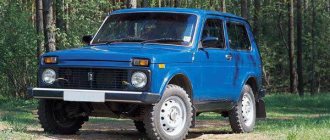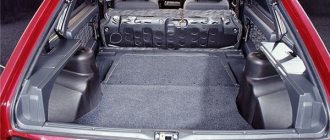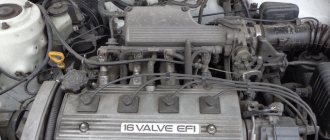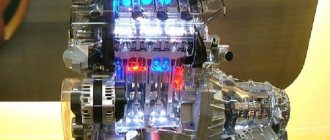VAZ 21214 is a passenger car, characterized by increased cross-country ability, equipped with a five-speed gearbox and a transmission with permanent all-wheel drive. In addition, there is a two-stage transfer case. Body type - “Hatchback”, the morally and technically outdated “four-speed” gearbox, which was equipped with previous models, was replaced on 21214 by a more modern and functional five-speed gearbox.
History of Niva
VAZ 21214 is a passenger car, characterized by increased cross-country ability, equipped with a five-speed gearbox and a transmission with permanent all-wheel drive. In addition, there is a two-stage transfer case.
In 1969-1970, VAZ chief designer V.S. Solovyov came up with the initiative to develop an all-terrain vehicle for residents of rural areas. His proposal was the result of the development of the so-called “type” of the USSR Ministry of Automotive Industry for 1971-1980.
The first production model of the VAZ-2121 rolled off the VAZ assembly line on April 5, 1977. Soon after the launch of the assembly line, the production plan for the all-wheel drive vehicle was increased from 25,000 vehicles per year to 50,000 vehicles, and then to 70,000 units precisely due to success in export markets.
In an interview with Itogi magazine, the creator of the Niva, Pyotr Mikhailovich Prusov, said that the car was named in honor of Prusov’s children - Natalya and Irina, and the children of the first chief designer of VAZ V.S. Solovyov - Vadim and Andrey [
The vehicle body is classified as a station wagon, which means it has a spacious trunk, the volume of which ranges from 265 to 980 liters, and a spacious interior. Niva 21214, the technical characteristics of which ensure its acceleration to 100 km/h in 17 seconds, is classified as an all-terrain vehicle. The car is not intended for reckless drivers or those who like to drive fast. Its maximum speed is 137 km/h, which, in principle, is typical for an SUV. The car has three doors - two at the front for passengers and the driver, and one at the back for the luggage compartment. The cabin has five seats, so the car is a passenger car.
This car can be driven on any road. It is designed both for off-road driving and for city highways.
Driving on roads of poor quality is not particularly difficult for the Niva 212214. The car is well controlled, reliable and stable on steep climbs, descents, turns, humps, holes, depressions, etc. The car interior is roomy, comfortable, and equipped with a safety system. The car body is made of all-metal material, which protects it from external mechanical damage.
In October 2016, on the LADA 4×4, VAZ introduced a bearing into the front hubs that does not require periodic adjustment. The car has a modernized steering knuckle, independent mounting of the front axle gearbox and gas-filled shock absorbers
Niva has also achieved success in motorsport, becoming a winner of such prestigious rally raids as Paris-Dakar, Paris-Tunisia, Pharaoh Rally, Paris-Beijing and others. For many years, the official VAZ dealer in France, Jean-Jacques Pocq, entered a team on Nivas at his own expense to participate in the Dakar marathon. Also for European owners of the VAZ-2121 there were competitions “Nivalp”, which can be compared with the Camel Trophy series.
Chassis
Fuel tank 58.0 Engine cooling system 8.0 Engine lubrication system 3.75 Gearbox housing 1.6 Transfer case housing 0.79 Front axle housing 1.15 Rear axle housing 1. So, for example, until October 2003, the power plant was produced with a lower location of the generator, and the auxiliary units were driven by 2 V-belts.
Niva's world achievements
- World altitude record: in 1998, the Niva all-terrain vehicle climbed to the base camp near Everest to a height of 5200 m, and in 1999, on the Tibetan plateau in the Himalayas, it reached a height of 5726 m above sea level;
- “Niva” conquered the North Pole - during an international parachute campaign in April 1998, a VAZ-2131 “Niva” was dropped with a parachute, and after landing on the ice and freed from the lines, it was started up and successfully covered the given route;
- The Niva served for 12 years at the Russian polar station Bellingshausen in Antarctica, where roads do not exist in principle. The Togliatti all-terrain vehicle was operated in the temperature range from −54 to +40 °C for transporting goods and towing ships. The total mileage of the car was 11,800 km;
- In 1999 and 2000, the Lada-Niva-Marsh all-terrain vehicle, built on Niva units, conquered the North Pole twice.
Motor oils
| Oil brand | SAE viscosity grade | Group | Manufacturer | Regulatory document | |
| AAI | AP1 | ||||
| LUKOIL LUX | 5W-30, 5W-40 10W-40,15W-40 | B5/D3 | SJ/CF | LLC "Lukoil-Permnefteorg-sintez", Perm | STO 00044434-003 |
| LUKOIL LUX | 0W-40, 5W-20, 5W-30, 5W-50, 10W-30 | B5/D3 | SL/CF | LLC "Lukoil-Permnefteorg-sintez", Perm | STO 00044434-003 |
| TNK SUPER | 5W-30, 5W-40 10W-40 | B5/D3 | SJ/SL/CF | TNK Lubricants LLC, Ryazan | TU 0253-008-44918199 |
| TNK MAGNUM | 5W-30, 5W-40 10W-40,15W-40 | B5/D3 | SJ/SL/CF | TNK Lubricants LLC, Ryazan | TU 0253-025-44918199 |
| ROSNEFT MAXIMUM | 5W-40, 10W-40 | B5/D3 | SL/CF | OJSC "Novokuibyshevsk Oil and Additives Plant", Novokuibyshevsk | TU 0253-063-48120848 |
| ROSNEFT OPTIMUM | 10W-30, 10W-40 15W-40 | B5/D3 | SJ/CF | OJSC "Novokuibyshevsk Oil and Additives Plant", Novokuibyshevsk | TU 0253-062-48120848 |
| ROSNEFT MAXIMUM | 5W-40, 10W-40 | B5/D3 | SL/CF | OJSC "Angarsk Petrochemical Company", Angarsk | TU 0253-391-05742746 |
| ROSNEFT OPTIMUM | 10W-30, 10W-40 15W-40 | B5/D3 | SJ/CF | OJSC "Angarsk Petrochemical Company", Angarsk | TU 0253-389-05742746 |
| ROSNEFT PREMIUM | 0W-40, 5W-40 5W-40 | B5/D3 | SJ/CF SL/CF SM/CF | OJSC "Angarsk Petrochemical Company", Angarsk | TU 0253-390-05742746 |
Continuation of the table. 2
| Oil brand | SAE viscosity grade | Group | Manufacturer | Regulatory document | |
| AAI | API | ||||
| EXTRA 1 EXTRA 5 EXTRA 7 | 5W-30 15W-40 20W-50 | B5/D3 | SJ/CF | OJSC "Omsk Oil Refinery", Omsk | TU 38.301-19-137 |
| EXTRA | 5W-30, 10W-40, 15W-40 | B5/D3 | SL/CF | OJSC "Omsk Oil Refinery", Omsk | TU 38.301-19-137 |
| ESSO ULTRA | 10W-40 | B5/D3 | SJ/SL/CF | Exxon-Mobil, Germany | |
| GTTURBO SM | 10W-40 | B5 | S.M. | Hanval INC, Korea | |
| LIQUI MOLY OPTIMAL | 10W-40 | B5/D3 | SL/CF | Liqui Moly GmbH, Germany | |
| MOBIL 1 MOBIL SYNT S MOBIL SUPER S | 0W-40, 5W-50 5W-40 10W-40 | B5/D3 | SJ/SL SM/CF SJ/SL/CF | Exxon-Mobil, Germany | |
| MOBIL 1 ESP FORMULA | 5W-30 | B6/D3 | SJ/SL SM/CF | ||
| RAVENOL HPS RAVENOL VSI RAVENOL LLO RAVENOL TSI RAVENOL Turbo-C HD-C | 5W-30 5W-40 10W-40 10W-40 15W-40 | B5/D3 | SL/CF SL/CF SL/CF SL/CF SJ/CF | Ravensberger Schmirstoffvertrieb GmbH, Germany | |
| SHELL HELIX: PLUS PLUS EXTRA ULTRA | 10W-40 5W-40 5W-40 | B5/D3 | SL/CF | SHELL EAST EUROPE Co, UK, Finland | |
| ZIC A PLUS | 5W-30, 10W-30, 10W-40 | B5 | SL | SK CORPORATION, Korea | |
Note. The oil change period is in accordance with the vehicle service book.
RECOMMENDED TEMPERATURE RANGES FOR APPLICATION OF MOTOR OILS
| Minimum engine cold start temperature, 0C | Viscosity grade according to SAE J 300 | Maximum ambient temperature, 0C |
| below -35 | 0W-30 | 25 |
| below -35 | 0W-40 | 30 |
| -30 | 5W-30 | 25 |
| -30 | 5W-40 | 35 |
| -25 | 10W-30 | 25 |
| -25 | 10W-40 | 35 |
| -20 | 15W-40 | 45 |
| -15 | 20W-40 | 45 |
Niva 21214: technical specifications
BODY
- Body type station wagon
- Number of seats 4
- Number of doors 3
ENGINE
- Engine type four-cylinder, in-line, four-stroke
- Engine capacity, cubic meters cm 1690
- Power, hp/rpm 80/5200
- Torque, Nm/rpm 127.5/5200
- Ignition system ECM - electronic engine management system
- Valves per cylinder: 2
- Valve and camshaft arrangement overhead valve with overhead camshaft
- Engine location front, longitudinal
- Power supply system: distributed fuel injection
DRIVE UNIT
- Drive type: permanent all-wheel drive
- (there is a center differential lock)
- checkpoint
- Mechanical 5
- (plus reduction gear)
SUSPENSION
- Front independent double wishbone
- Rear dependent
BRAKES
- Front disc
- Rear drums
SPEED
- Maximum speed, km/h 142
- Acceleration to 100 km/h, from 17
FUEL
- Fuel type gasoline AI-95
- Consumption, l per 100 km
- (with mixed cycle) 10.8
DIMENSIONS
- Length, mm 3740
- Width, mm 1680
- Height, mm 1640
- Wheelbase, mm 2200
- Front wheel track, mm 1430
- Rear wheel track, mm 1400
- Ground clearance, mm
- (for tires 6.95-16 with a static radius of 322 mm.) 220
- Curb weight, kg 1210
- Permitted maximum weight (RMM), kg 1610
- Trunk volume, l in standard rear seat position 285
- with rear seat fully folded 585
- Fuel tank volume, l 42
Engine
The power unit was left virtually unchanged - it is still the same 1.7-liter engine with distributed fuel injection, meeting the Euro-4 toxicity standard. The changes include the installation of more modern and reliable sealing materials with a silicone bead, a new type of water pump oil seal, as well as a new fuel supply system with quick-release connections. All engine characteristics also remain the same.
Transmission
The transmission has been modernized much more seriously. First of all, a new clutch from Valeo was installed - the same one that is installed on the NIVA-Chevrolet. As a result of this, the resource of this unit almost doubled, and the Niva 21214m car itself became less susceptible to vibration due to a reinforced damper spring and an enlarged disk.
A more efficient crankcase ventilation system was installed on the transfer case, the cardboard seals were replaced with silicone ones, and they began to be equipped with new seals.
Due to the fact that more stringent requirements are now applied to the production of cardan shafts, which primarily relate to balancing accuracy, their service life has increased, and noise and vibration have decreased by approximately 80%.
Suspension and chassis
The most significant changes affected the suspension - it was optimized and almost completely unified with the well-proven NIVA-Chevrolet suspension:
- New front suspension steering knuckles;
- The front suspension has lower control arms with modern silent blocks;
- Front wheel alignment angles have been changed;
- Front axle of increased diameter;
- Reinforced brackets;
- New ball joints with an increased swing angle, forged body and liner made of polymer materials;
- Modern gas-oil shock absorbers with increased travel and service life;
- Optimized layout of the lower rods and arms in the rear suspension.
Other liquids and fuels and lubricants
Every car enthusiast should know by heart the maximum fuel capacity of his car. The fuel tank of the VAZ 21213 has a capacity of 42 liters, including reserve. The reserve refers to the amount of fuel remaining in the tank after the yellow warning light on the instrument panel turns on. The reserve amount is at least 5 liters. The car must be fueled with gasoline whose octane number is in the range of 91-93.
The car has a number of refueling tanks that the owner must monitor during operation:
- brake system with expansion tank, total capacity - 0.515 l;
- hydraulic clutch drive with expansion tank - 0.2 l;
- 2 plastic tanks with a volume of 2 liters each contain a supply of windshield and rear window washer fluid.
The clutch release drive and brake system are filled with hydraulic brake fluid (the most popular is DOT-4). It should be changed at least every 3 years, because the liquid has the ability to absorb water vapor contained in the air. As a result, all steel parts of the system in contact with it begin to corrode, which leads to complete or partial failure of the brakes.
If there is a leak in the clutch or brake system, the level in the expansion tanks decreases, so constant monitoring is required over them.
The level of brake fluid in the reservoirs must be maintained no lower than the corresponding mark on the plastic body of the container.
Liquid or clean water for washing glass is added if necessary; in winter, a non-freezing option is required. Otherwise, the ice will not only destroy the tubes, but also damage the electric pump.
Various thick lubricants are also used for maintenance and lubrication of the Niva:
- Litol - a composition for lubricating highly loaded bearing parts;
- CV joints-4 - lubricant for the hinges of the front axle shafts and door opening limiters;
- ShRB-4 is designed for processing ball joints and steering rods.
Price policy
For Niva 21214, the price, depending on the showroom and dealer, is about 370-380 thousand rubles - this is the “Standard” package. When ordering additional options, it may increase slightly.
BRIEF CHARACTERISTICS FOR LADA 4X4 (3 doors) 1.7 L 8 KL. (83 HP), 5MT (2017)
BRIEF CHARACTERISTICS FOR LADA 4X4 (5 doors)
BRIEF SPECIFICATIONS FOR LADA 4X4 Urban (3 doors)
DETAILED TECHNICAL CHARACTERISTICS OF VAZ-21213 and 21214 CARS
VAZ-21213 and its modifications are all-terrain passenger cars. All wheels are constantly driven (non-disconnectable all-wheel drive), there is a center differential locking mode. The body is load-bearing, all-metal, welded. Engine – four-cylinder, in-line, petrol, four-stroke; location – anterior, longitudinal. The VAZ-21213 is equipped with a carburetor engine mod. 21213 with a displacement of 1.7 liters, on the VAZ-21214 - engine 21214 of the same volume with distributed fuel injection. (Previously, VAZ-21214 cars were equipped with a 21214 engine with central fuel injection and a microprocessor ignition system). VAZ-21215 (supplied for export) is equipped with a diesel engine XUD-9SD with a displacement of 1.9 liters from the Peugeot-Citroen concern.
VAZ-21214 vehicles are equipped with a toxicity reduction system with a three-component neutralizer. To avoid failure of the converter and oxygen sensor, it is prohibited to operate these vehicles on leaded gasoline.
Options
VAZ-21213
All-metal, load-bearing, two-volume
Number of seats (with rear seats folded)
Curb weight, kg
Total weight, kg
Ground clearance of a vehicle with a full load with a static tire radius of 315 mm (175/80R16)/ 322 mm (6.96-16), not less, mm:
221/228
Total weight of the towed trailer, kg:
400
Minimum turning radius along the track of the outer front wheel, m
Maximum speed*, km/h:
137
Acceleration time* from standstill to 100 km/h, s:
19
Maximum incline overcome by a vehicle with a full load without accelerating in first gear, %
VAZ 21214 is a passenger car, characterized by increased cross-country ability, equipped with a five-speed gearbox and a transmission with permanent all-wheel drive. In addition, there is a two-stage transfer case. Body type - “Hatchback”, the morally and technically outdated “four-speed” gearbox, which was equipped with previous models, was replaced on 21214 by a more modern and functional five-speed gearbox.
VAZ-21214 engine modifications
| 21214-41 | modification with a power steering pump, with a welded steel manifold, YAZTA hydraulic supports, Euro 3. |
| 21214-34 | modification without power steering pump, with cast iron manifold, INA hydraulic mounts, Euro 3. |
| 21214-33 | modification with power steering pump, cast iron manifold, INA hydraulic mounts, Euro 3. |
| 21214-32 | modification with power steering pump, cast iron manifold, INA hydraulic mounts, fuel pipes for quick connectors, flywheel for clutch 215mm, Euro 3. |
| 21214-31 | modification with power steering pump, steel welded manifold, INA hydraulic supports, Euro 4. |
| 21214-30 | modification without power steering pump, with welded steel manifold, INA hydraulic supports, Euro 4. |
Photo engine VAZ-21214
VAZ 21214 is a passenger car, characterized by increased cross-country ability, equipped with a five-speed gearbox and a transmission with permanent all-wheel drive. In addition, there is a two-stage transfer case. Body type - “Hatchback”, the morally and technically outdated “four-speed” gearbox, which was equipped with previous models, was replaced on 21214 by a more modern and functional five-speed gearbox.
Description
The geometric parameters of cross-country ability are good due to the fairly high ground clearance (220 mm), small body overhangs (approach angle 32, departure angle 37) and a relatively short 2.2-meter wheelbase.
VAZ-21214 (Lada 4×4) - modification of model 21213 with the VAZ-21214 engine (1.7 l, 82.8 hp, 127.5 Nm) equipped with central fuel injection. Since 2002, this model has been equipped with a VAZ-21214-10 (Euro-0) engine with distributed fuel injection, upgraded in 2006 to Euro-2 standards (21214-20), in 2008 to Euro-3 (21214- 30) and, finally, in 2011 to Euro-5 (for export) and Euro-4 (for domestic consumption) standards.
What has changed in the VAZ 21214 engine?
Changes affected the valve mechanism. Now, in order to eliminate the gap, it is necessary to use hydraulic supports for the valve levers, instead of the usual adjusting bolts. Oil is supplied under pressure to each hydraulic mount through a separate pipeline.
Minor changes have also been made to the valve lever. In the new one, the radius support pad, which is in contact with the distribution cam, has decreased by 11 mm. The lever can be distinguished by the second groove on the outside (from the side of the hydraulic support).
The camshaft drive had to be significantly modified. A single-row bushing-roller chain is now used instead of a double-row. This entailed replacing all the drive sprockets on the engine with single-row ones installed on the 2123 engine. There are only 30 teeth on the oil pump sprocket, which makes it possible to increase the performance of the oil pump and, thereby, ensure reliable operation of the hydraulic pushers and hydraulic tensioner.
The engine has an 80A generator installed. Its characteristics coincide with the generator model 2112. But installing a new pulley with an outer diameter of 80 mm on it allowed the generator to be given a new index 21214.
Depending on the model, the engine may have a cast iron or welded (stainless steel) exhaust manifold. The use of a welded structure made it possible to reduce the mass of the collector, which contributed to accelerated heating of the converter.
Niva's fuel consumption is acceptable! • Basic methods
| Technical characteristics of VAZ 2121 (4×4) 21214 1. 7 MT 4WD, 83 l. With. (2002-2020 production) For reference, we note that the water pump, power steering pump and generator are driven by a steel pulley mounted on the crankshaft using a Gates or Continental serpentine belt; the system uses support and tension rollers. The VAZ engine is characterized by systematic overheating, increased oil consumption, noise at idle, periodic tripping when cold, frequent knocking and failure of spark plugs. |
| Technical characteristics of VAZ 2121 (4×4) 21214 1. 7 MT 4WD, 83 l. With. (2002-2020 production) Niva 21214, the technical characteristics of which meet all the requirements for an SUV, is an excellent assistant and reliable means of transportation and cargo transportation. In the event that you will be driving in areas with increased swampiness, the Niva 21214, the technical characteristics of which fully allow this, will behave better with a snorkel installed. |
- DOT-4 brake fluid is suitable for half-liter hydraulic brakes. The product has improved characteristics and has a boiling point of over 235 degrees. Well suited for regions with low ambient temperatures.
- SAEJ1703, FMSS116 are used for the entire hydraulic system and clutch release (0.15 l). The synthetic product provides good lubrication and reduces oxidation at high temperatures.
- The tank lid hatch hinges, door and hood locks require VTV-1 and FIOL-1 greases. Hinges of steering rods and cardan shafts - ShRB-4, Litin 2, Esma.
- The air conditioner also has two tanks. One of them is for oil (0.22 l), the other is for refrigerant (0.650 kg).
Cost depending on the configuration • Rear suspension element of dependent type with longitudinal and transverse linkage device.
Advantages and disadvantages of the car - Main characteristics
The fuel consumption of a Niva car depends on the cycle: in the urban cycle, the Niva spends about 11 liters per 100 km; in the suburban mode, the speed of 90 km/h consumes 8.7 liters of fuel; in mixed mode, the Niva consumes 10.8 liters. Strengths Structurally simple and unpretentious engine, which has been thoroughly studied by auto mechanics, so there should not be any special problems with repairs.
| Fuel tank | 58,0 |
| Engine cooling system | 8,0 |
| Engine lubrication system | 3,75 |
| Gearbox housing | 1,6 |
| Transfer case housing | 0,79 |
| Front axle housing | 1,15 |
| Rear axle housing | 1.3 |
| Hydraulic brake system | 0,5 |
| Hydraulic shutdown system | 0,15 |
| clutch | |
| Windshield washer reservoir | 5,0 |
| Tailgate glass washer reservoir | 2,0 |
| Front shock absorber | 0,15 |
| Rear shock absorber | 0,215 |
| Power steering | 1,7 |
Why did it happen so?. Chassis
Narrow headlights with built-in running lights, multi-level architecture of the front of the car, rectangular wheel arches instead of semicircular ones, LED taillights, roof rails, changes affected almost all elements and parts of the car. The engine's electrical system is capricious, especially when it comes to wiring, which tends to short out even at low mileage, which subsequently leads to more serious consequences for the electrical equipment.
| Engine make | VAZ 2106 |
| Engine capacity, cubic meters cm | 1569 |
| Number of valves | 8 |
| Maximum power, hp | 73 |
| Transmission type | 5 manual transmission |
| Speed at maximum power, rpm | 5400 |
| Maximum torque, N*m | 116 |
| Speed at maximum torque, rpm | 3000 |
| engine's type | in-line, 4-cylinder |
| Supply system | carburetor |
| Recommended fuel | gasoline AI-92 |
| Fuel consumption | |
| Fuel consumption in the urban cycle, l/100 km | 10,3 |
| Fuel consumption in the extra-urban cycle, l/100 km | 7,4 |
| Fuel consumption in the combined cycle, l/100 km | 10 |
| Dynamic indicators | |
| Acceleration time 0-100 km/h, s | 17 |
| Maximum speed, km/h | 142 |
Features of the fuel tank volume. Driving capabilities
It is especially important to remember that in hot weather it is not advisable to fill the fuel tank to the limit, since it must contain a small reserve of volume to compensate for expansion and fuel vapor. The power unit in question is not at all picky about the fuel that is poured, you can safely pour 92-grade gasoline and engine oil, just do not forget about periodic replacement of the lubricant.
| Lower limit of ambient temperature, °C | -15 | -25 | -25 | -30 | -40 |
| Upper limit of ambient temperature, °C | +45 | +45 | +35 | +45 | +35 |
| SAE lubricant viscosity grade | 85W-90 | 80W-90 | 80W-85 | 75W-90 | 75W-80 75W-85 |











